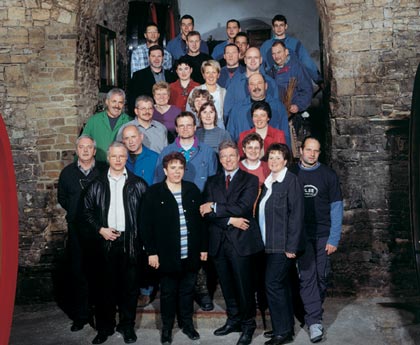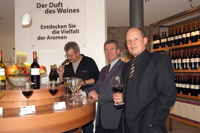 |
| The WGN team in front of the historic cellar |
Modern times
Founded in 1951, today 247 member farms, 298 ha under cultivation, an annual production of 2.2 million litres, an annual turnover of 7 million euros. These are the bare figures describing the WG Nordheim.
But things have changed in the last five years. A plan was developed. The range of grape varieties was to be more narrowly focused, the quality orientation further improved, the market presence refined.
On 11 April 2003, the Nordheimers proudly presented the result of their efforts to a broad public.
Life in wine sound
This is the new slogan of the Nordheim Winegrowers' Cooperative (WGN). The most visible and imposing expression of the transformation of the WG Nordheim into a sustainable and modern enterprise is the new building. Modestly called "Vinothek DIVINO", this building can set standards. "We deliberately opted for a modern architectural style" and "We wanted to get away from the three Franconian 'B's: Baroque, Bratwurst, Bocksbeutel", says Oskar Georg Noppenberger, the managing director of WG Nordheim. The fact that this decision was not always easy to make is freely admitted.
The result is a spacious, friendly building. Noppenberger points out that only local wood was used, natural stone dominates the visible walls, warm colours determine the interior. A number of individual components can be found on 1,000 square metres spread over three floors:
 |
| Paul Glaser% Oskar Georg Noppenberger and Dr. Kolesch at the aroma counter. |
An aroma counter is set up in the entrance area. Here, guests can sniff their way through different aroma samples. The wines of the WGN that match the aroma samples are also available; the curious guest can easily check whether the Silvaner really smells like green apples.
To the left of the Aromarade is an elegantly curved wooden counter, where purchases can be made. On the right-hand side of the ground floor is the assortment. In addition to the wines, there are also brandies, accessories and confectionery, etc. Here too: plenty of space, everything is very bright, nothing looks like a salesroom, the design is coherent and fits into the overall picture.
A bistro adjoins, with floor-to-ceiling windows overlooking the inner courtyard. As Oskar Georg Noppenberger emphasises, the aim is to offer light, fresh cuisine. They are particularly proud of the espresso machine: a replica of one from 1961.
A curved staircase leads to the first floor. Again, it is the details that attract attention. A walk-in installation called "media snail" leads inside to a small room that can be used for video presentations.
There is also plenty of space for art on the first floor. Four exhibitions by renowned artists are planned each year. The selection of artists is the responsibility of an art advisory board headed by Dr Bernd Goldmann, director of the international artists' house Concordia, Bamberg. Bettina Kresslein, whose colourful paintings deal with the theme of "wine and people", has the honour of opening the exhibition.
In addition to the exhibition, there is also a library on the first floor. Guests can immerse themselves in a book while sipping a glass of wine. Another nice detail: In the library area there is a computer station where guests can design their own wine labels. There is also a facility for printing out the labels. These printouts can be handed in downstairs and the purchase will be fitted with the individual labels. The legally required information is then placed on another label.
In the basement of the building, a very atmospheric meeting and event room has been set up. By means of an elaborate lighting installation, the mood can be varied from businesslike, cool, bright to romantic, dreamy. Separated from this room by a glass wall is the barrique cellar, which can also be used for tastings.
And the wines?
The Nordheimers also present their wine range in a new orientation and a new look. Three new brands have been created: "Divino", "Juventa" and "Franconia" are the names of these lines. The Nordheim company does not want to achieve a qualitative differentiation, but rather a stylistic one.
"Franconia" addresses the tradition-conscious lover of Franconian wines. Classical grape varieties, typicality of vineyards with a modern and contemporary interpretation is the orientation of this brand.
The other two product lines, "Divino" and "Juventa", do not include any vineyard names. Fresh, fruit-driven wines are offered under the "Juventa" brand, while the "Divino" range is intended to summarise international grape varieties and vinification styles.
The use of "Classic" and "Selection" will be dispensed with. "Classic and Selection are mainly designations for the food retail trade in order to offer customers orientation at the shelf," says Oskar Georg Noppenberger. Since Nordheim focuses on direct marketing, there is no need to use these names.
A modern bottle design is also part of the new brand strategy.
The Nordheim comrades have already proven in recent years that they are firmly anchored in the upper third of quality in Franconia, which is also reflected in a star in the Wein-Plus wine guide. With the new wines, they want to expand this position.
"If it were up to me, all wines would have screw caps," says Paul Glaser, wine consultant at Nordheim. It may be regrettable that the current collection is still completely corked with natural corks. So the step towards alternative closure systems is still ahead for the Nordheimers.
With the support of the Bavarian state, 3 million euros were invested in the new building. Of course, problems did not go unnoticed: A water ingress in the basement a few weeks ago even jeopardised the long-planned inauguration date. The unusually long frost period prevented the exterior work from being completed on time. But despite all the adversities: only 80 km from Nuremberg, 30 km from Würzburg, a world of experience around wine has been created. In addition to the vinotheque, hiking trails, raft tours on the Main, excursions by bike and a charming landscape offer enough incentives for a visit. Perhaps the new vinotheque "Divino" will also develop a tourist pull. It will certainly be exciting to watch the development of the WGN in the coming years!
Photos (in part): Claudia Dankert
To the WGN in the wine guide